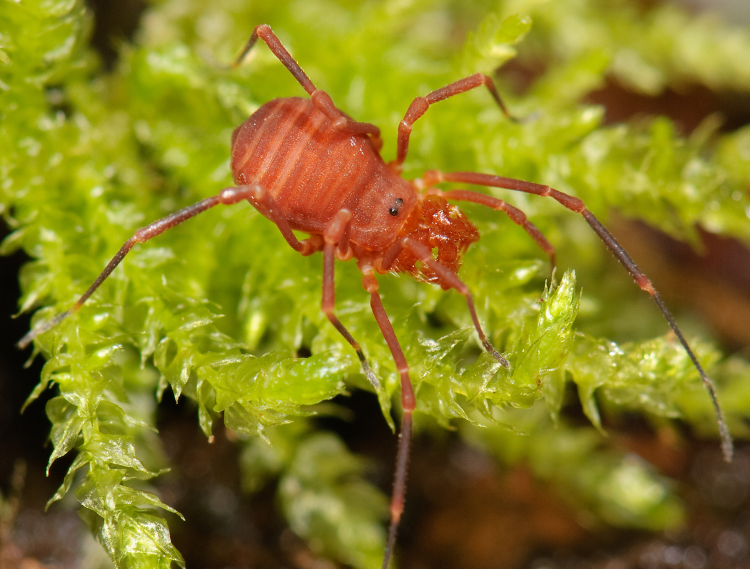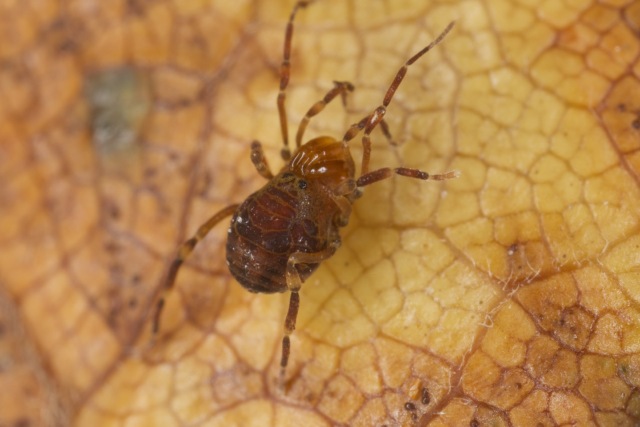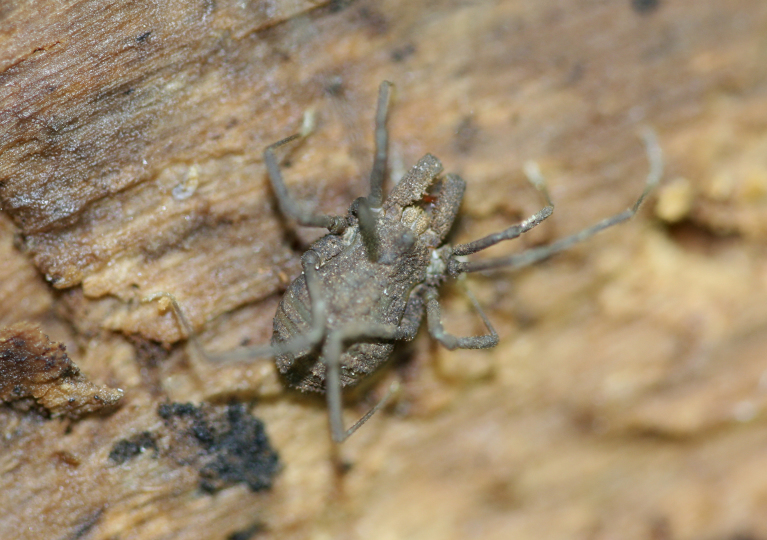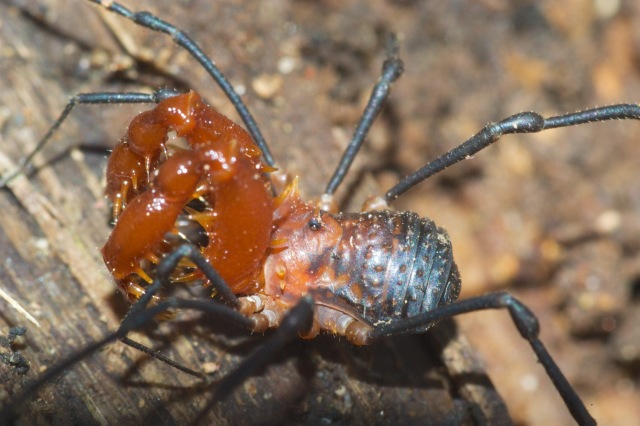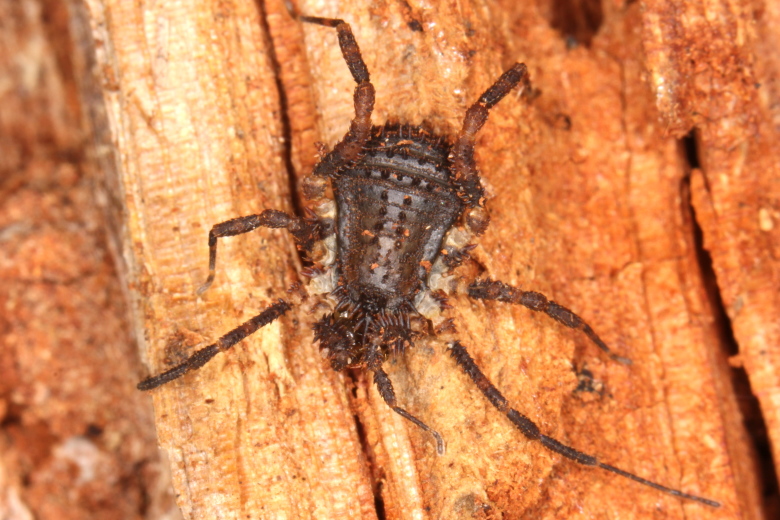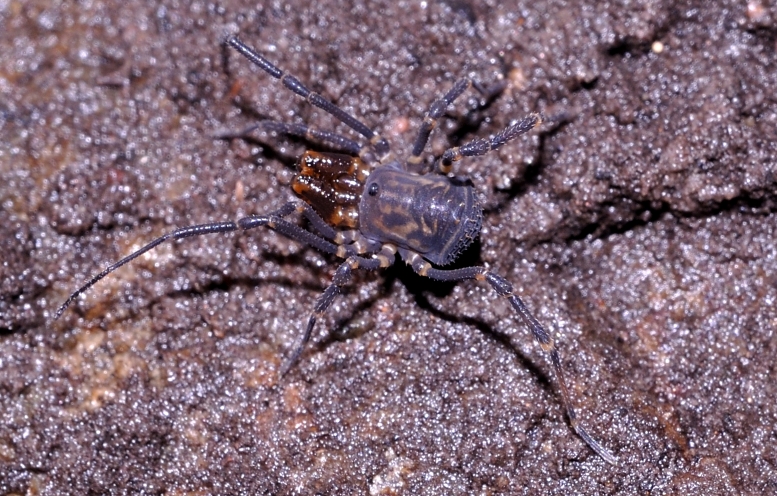Abstract Abstract
Comprising more than 6500 species, Opiliones is the third most diverse order of Arachnida, after the megadiverse Acari and Araneae. The database referred here is part 1 of 12 of a project containing an intended worldwide checklist of species and subspecies of Opiliones as Darwin Core archives, and it includes the superfamilies Travunioidea and Triaenonychoidea. These two superfamilies are often treated together under the denomination of Insidiatores. In this Part 1, a total of 571 species and subspecies are listed. Briggsidae and Cladonychiidae are both downgraded to subfamilies of Travuniidae. Peltonychia Roewer, 1935 is an available name and senior synonym of Hadziana Roewer, 1935 and is herein revalidated. Seven genera of Triaenonychidae described by Lawrence between 1931 and 1933 originally failed to comply ICZN rules for availability (Art. 13.3). All of them only became available when Staręga (1992) designated a type species for each. Therefore, the correct authorships of Austromontia Lawrence, 1931, Biacumontia Lawrence, 1931, Graemontia Lawrence, 1931, Larifugella Lawrence, 1933, Mensamontia Lawrence, 1931, Monomontia Lawrence, 1931 and Rostromontia Lawrence, 1931 are all Staręga, 1992. Fumontana Shear, 1977, originally referred only to subfamily Triaenonychinae (as opposed to Soerensenellinae then and not corresponding to present Triaenonychinae), not to any tribe (which in turn correspond to modern subfamilies) is herein included in the subfamily Triaenonychinae. Picunchenops Maury, 1988 originally not included in any tribe of Triaenonychidae, is herein included in the subfamily Triaenonychinae. Trojanella Karaman, 2005, originally ranked as Travunioidea incertae sedis, is herein included in the Travuniidae Travuniinae. Nuncia ovata Roewer, 1915 (synonymized with Triaenonyx cockayni Hogg, 1920 by Forster (1954), but with inverted precedence) is here combined as Nuncia coriacea ovata Roewer, 1915 as correct senior synonym instead of Nuncia coriacea cockayni (Hogg, 1920), which is current in the literature. Neonuncia enderbei (Hogg, 1909) is reaffirmed as the correct spelling for the species, while the deliberate change to Neonuncia enderbyi by Forster (1954) is an incorrect subsequent spelling.
Keywords: Harvestmen, Afrotropical, Australasian, Nearctic, Neotropical, Palearctic
Introduction
Placement and composition
For decades, Travunioidea and Triaenonychoidea have been historically regarded as a single unit, called Travunioidea (e.g., Martens 1980). Kury (2003) resurrected the name Insidiatores Loman 1900 to collectively refer to them, but subsequent authors failed to recover the monophyly of Insidiatores (Giribet and Kury 2007) and even of the component families (Sharma and Giribet 2011).
Both morphological (Mendes 2009) and molecular (Giribet et al. 2010, Sharma and Giribet 2011) phylogenetic analyses found that the Palearctic “Triaenonychidae” group with expanded Travuniidae and Travunioidea. Kury (2013) following results of Mendes (2009) fused Briggsidae and Cladonychiidae with Travuniidae, which is also supported by Giribet et al. (2010) and Sharma and Giribet (2011). Herein we adopt this scheme of classification, and downgrade Briggsidae and Cladonychiidae to subfamilies of Travuniidae further. Mendes (2009) found that the Triaenonychoidea sensu stricto are sister to Grassatores, not to Travunioidea, in contrast with Giribet and collaborators, who found Triaenonychidae as sister group of Travunioidea. Giribet et al. 2010 and Sharma and Giribet 2011 found Synthetonychiidae as the sister group to all other Laniatores, but this placement is not incorporated here.
The North American monotypic Fumontana Shear, 1977 is probably closely related to the southern triaenonychids, although its exact positioning in the family is still unknown (Giribet and Kury 2007, Thomas and Hedin 2008, Mendes 2009). It is currently the only representative of Triaenonychoidea from the Northern Hemisphere. The only analysis with broader representation of Insidiatores (Mendes 2009) found Fumontana closer to Triaenonyx Sørensen, 1886 than to Soerensenella Pocock, 1902, Triaenobunus Sørensen, 1886 and Adaeum Karsch, 1880 hence we consider this species here as a member of the subfamily Triaenonychinae.
According to the results of Mendes (2009), Trojanella serbica Karaman, 2005, currently considered a Travunioidea incertae sedis (Karaman 2005), groups with the European travunioids, forming a clade with Travunia Absolon, 1920, and based on those results we newly assign this species to Travuniidae, subfamily Travuniinae. Mendes also included Picunchenops spelaeus Maury, 1988 in her analyses. Originally this species was placed by Maury (1988) in Triaenonychinae, but not to any of its tribes (which roughly corresponds to subfamilies). In her results, Mendes found that this species is closer to Triaenonyx and other triaenonychines, thus we consider herein this species as a Triaenonychidae, subfamily Triaenonychinae (or in Maury's terms, Triaenonychini).
We provide additional nomenclatural considerations in the section "Additional information".
Recent works on these groups
In the last years, some work has been done with North American Travunioidea. Shear (2008) synonymized a species of Cladonychiidae, Phalangomma virginicum Roewer, 1949 (originally assigned to Phalangodidae) with the travuniid Erebomaster weyerensis (Packard, 1888). Shear and Derkarabetian (2008) redefined Paranonychinae based on characters of the penis and proposed the synonymy of Kaolinonychinae as its junior synonym. Derkarabetian et al. (2011) and Derkarabetian and Hedin (2014) have been studying the sclerobunines using modern integrative taxonomy to detect morphological homogeneous undescribed species, synonymies and the evolution of troglomorphisms (Derkarabetian et al. 2011, Derkarabetian and Hedin 2014). Most recent published work on Triaenonychoidea is only cursory and on Afrotropical taxa (e.g., Mendes and Kury 2012), while Australasian and Neotropical members are neglected of late.
General description
Purpose
This project is a checklist of all valid specific and subspecific names (counted together) of the arachnid order Opiliones. The project intends to deliver 12 parts for ease of handling and preparing manuscripts. This is part 1 of 12 and covers the two basal superfamilies of Laniatores – the Travunioidea and the Triaenonychoidea.
Project description
Title
World Checklist of Opiliones species (Arachnida).
Personnel
Adriano B. Kury (Author, Content Provider, Metadata Provider), Amanda C. Mendes (Author, Content Provider), Daniele R. Souza (Author, Content Provider).
Design description
This project aims to produce a general checklist of all the valid species and subspecies (which are counted together) names of harvestmen of the world (Arachnida, order Opiliones). That is, only senior homonyms and synonyms are included. Alternative unused combinations are not listed.
Given the bulk of the project, it is divided in 12 parts as follows (numbers of subsequent parts are subject to change):
Part 1. Laniatores – Travunioidea and Triaenonychoidea (571 spp)
Part 2. Laniatores – Grassatores incertae sedis, Samooidea and Zalmoxoidea (564 spp)
Part 3. Laniatores – Assamioidea (529 spp)
Part 4. Laniatores – Epedanoidea and Phalangodoidea (539 spp)
Part 5. Laniatores – lesser Gonyleptoidea (506 spp)
Part 6. Laniatores – Cosmetidae (729 spp)
Part 7. Laniatores – Gonyleptidae (760 spp)
Part 8. Cyphophthalmi and Dyspnoi (552 spp)
Part 9. Eupnoi – incertae sedis, Caddidae, Neopilionidae and Phalangiidae (476 spp)
Part 10. Eupnoi – lesser Sclerosomatidae (289 spp)
Part 11. Eupnoi – Gagrellinae: Old World (741 spp)
Part 12. Eupnoi – Gagrellinae: New World (313 spp)
Funding
This study has been supported by grants # 562149/2010-4 (PROTAX – OPESC project), # 504327/2012-7 (Sistema de Informações sobre a Biodiversidade Brasileira (SiB-Br) - Coleções Biológicas) and scholarship # 302116/2010-9 (PQ - AMMA project) from the Conselho Nacional de Desenvolvimento Científico e Tecnológico (CNPq).
Geographic coverage
Description
General spatial coverage: worldwide. The Travunioidea and Triaenonychoidea together have 307 Australasian species, 159 Afrotropical, 40 Nearctic, 38 Palearctic, 26 Neotropical and only 1 Holarctic. As Travunioidea is a typical Laurasian group, while Triaenonychoidea represents a mostly temperate Gondwana fauna, there are no records of these groups from Indo-Malaya. Promecostethus unifalculatus Enderlein, 1909 from Crozet Island, French Subantarctic Lands is here listed as Australasian.
Taxonomic coverage
Description
This part 1 of the checklist includes the Insidiatores Loman 1900, which represent the basal Laniatores. Superfamilies Travunioidea and Triaenonychoidea. The taxonomic outline for large groups of Opiliones used here follows Kury (2013).
The Travunioidea have 78 valid species/subspecies, including 39 Nearctic, 38 Palearctic and 1 Holarctic taxa. Three families and 5 subfamilies are recognized here: Nippononychidae, Paranonychidae (Paranonychinae Fig. 1, Sclerobuninae Fig. 2), Travuniidae (Briggsinae Fig. 3, Cladonychiinae Fig. 4, Travuniinae Figs 5, 6).
Figure 1.
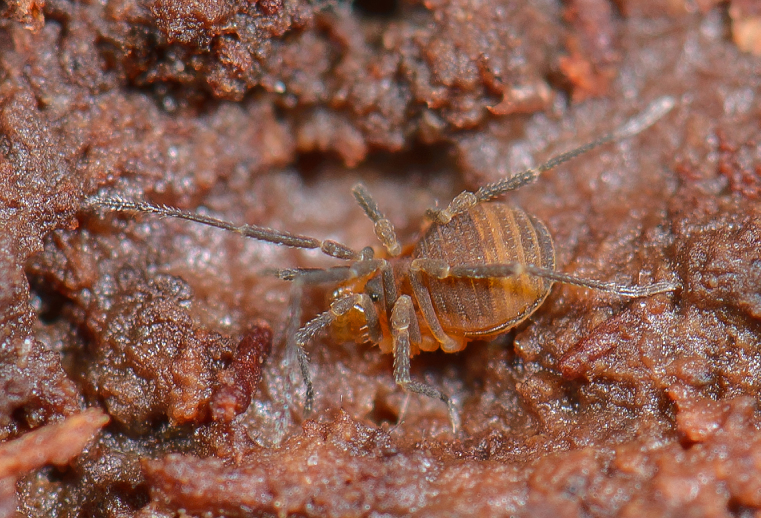
Paranonychidae, Paranonychinae, Paranonychus brunneus (Banks, 1893), adult, USA. Photo, ID and copyright © by Marshal Hedin. Image online at link.
Figure 2.
Paranonychidae, Sclerobuninae, Sclerobunus nondimorphicus Briggs, 1971, adult, USA, WA, Pacific Co.. Photo, ID and copyright © by Marshal Hedin. Image online at link.
Figure 3.
Travuniidae, Briggsinae, Briggsus sp., adult, collected by C. Richart & S. Derkarabetian, 3 April, 2008, USA, OR, Clatsop Co. Photographed in lab. Photo, ID and copyright © by Marshal Hedin. Image online at link.
Figure 4.
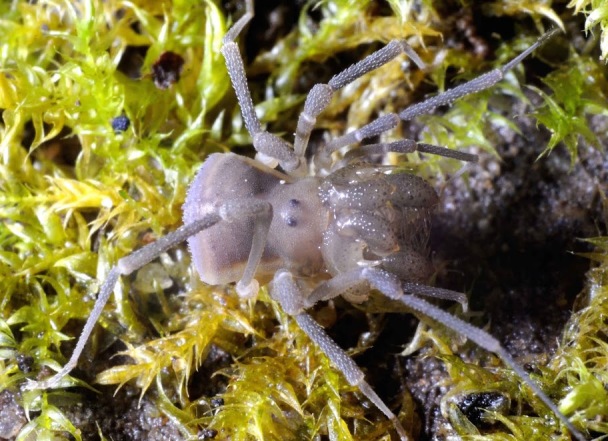
Travuniidae, Cladonychiinae, Cryptomaster leviathan Briggs, 1969, teneral adult, USA, OR, Curry Co., Lobster Creek Rd. Photo, ID and copyright © Axel Schönhofer. Image online at link.
Figure 5.
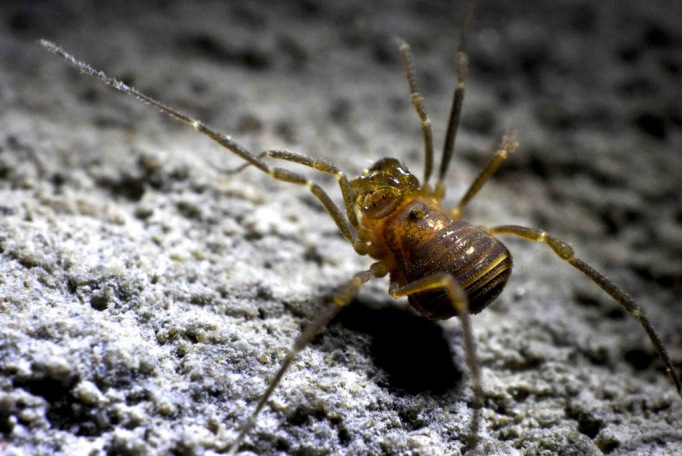
Travuniidae, Travuniinae, Peltonychia leprieuri (Lucas, 1861), adult, Italy Roncobello. Photo, ID and copyright © Axel Schönhofer. Image online at link.
Figure 6.
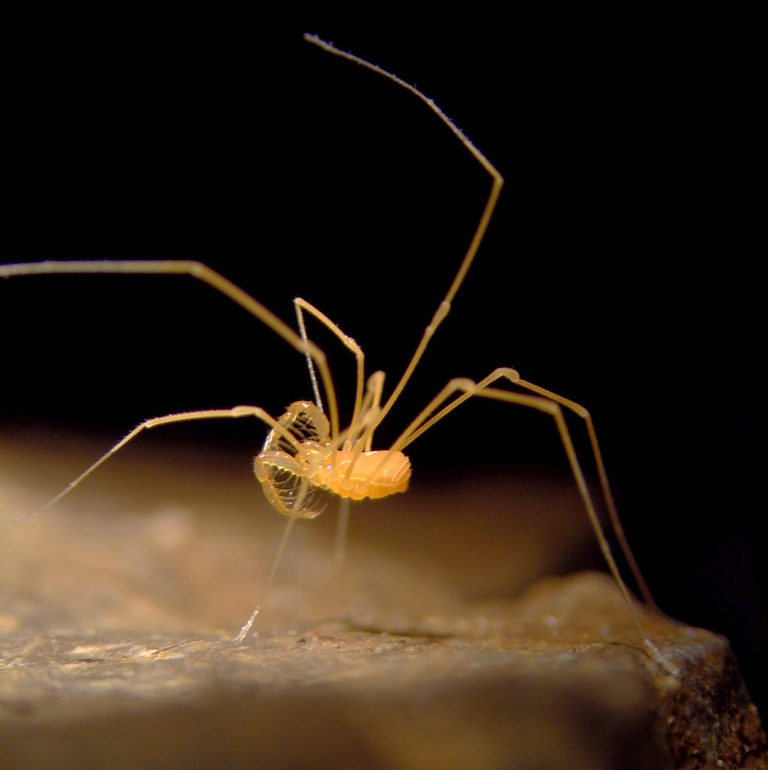
Travuniidae Travuniinae, Trojanella serbica Karaman, 2005, adult from Serbia, image cropped. Photo, ID and copyright © Ivo Karaman.
The Triaenonychoidea include 493 valid species/subspecies, with 307 Australasian, 159 Afrotropical, 26 Neotropical and 1 Nearctic taxa. A single species from the Crozet Islands is listed here as Australasian. Two families and 4 subfamilies are recognized here: Synthetonychiidae Fig. 7, Triaenonychidae (Adaeinae Fig. 8, Soerensenellinae Fig. 9, Triaenobuninae Fig. 10, Triaenonychinae Fig. 11).
Figure 7.
Synthetonychiidae, Synthetonychia sp., adult, New Zealand. Photo, ID and copyright © Gonzalo Giribet. Image online at link.
Figure 8.
Triaenonychidae, Adaeinae, Adaeulum sp. from South Africa, Hogsback. ID by Amanda C. Mendes. Photo and copyright © by Charles Haddad.
Figure 9.
Triaenonychidae, Soerensenellinae, Soerensenella sp., adult, New Zealand, Waikato. Photo, ID and copyright © Gonzalo Giribet. Image online at link.
Figure 10.
Triaenonychidae, Triaenobuninae, Triaenobunus sp. adult male, Australia, Tasmania, Hobart, Tolmans Hill. ID by Adriano B. Kury. Photo and copyright © by Kristi Ellingsen. Image online at link.
Figure 11.
Triaenonychidae, Triaenonychinae, Ankylonuncia sp. adult, Australia, Tasmania, Verona Sands, found under rock in boggy ground. ID by Amanda C. Mendes. Photo copyright © by Andrew Bonnitcha. Image online at link.
Taxa included
| Rank | Scientific Name | Common Name |
|---|---|---|
| kingdom | Animalia | animals |
| phylum | Arthropoda | arthropods |
| class | Arachnida | arachnids |
| order | Opiliones | harvestmen |
| suborder | Laniatores | |
| superfamily | Travunioidea | |
| family | Nippononychidae | |
| family | Paranonychidae | |
| subfamily | Paranonychinae | |
| subfamily | Sclerobuninae | |
| family | Travuniidae | |
| subfamily | Briggsinae | |
| subfamily | Cladonychiinae | |
| subfamily | Travuniinae | |
| superfamily | Triaenonychoidea | |
| family | Triaenonychidae | |
| subfamily | Adaeinae | |
| subfamily | Soerensenellinae | |
| subfamily | Triaenobuninae | |
| subfamily | Triaenonychinae | |
| family | Synthetonychiidae |
Temporal coverage
Data range: 1758 1 01 – 2014 8 31.
Usage rights
Use license
Open Data Commons Attribution License
Data resources
Data package title
World Checklist of Opiliones species (Arachnida). Part 1: Laniatores – Travunioidea and Triaenonychoidea
Resource link
Number of data sets
1
Data set 1.
Data set name
World Checklist of Opiliones species (Arachnida). Part 1: Laniatores – Travunioidea and Triaenonychoidea
Data format
Darwin Core Archive format
Number of columns
20
Character set
UTF-8
Download URL
Data format version
1.0
Description
Data set 1.
| Column label | Column description |
|---|---|
| taxonID | unique ID for each specie/subspecies |
| suborder | Laniatores, the only suborder contained in Part 1 of this project |
| superfamily | name of the superfamily |
| family | name of the family |
| subfamily | name of the subfamily |
| genus | name of the genus |
| specificEpithet | species name |
| infraspecificEpithet | subspecies name |
| scientificNameAuthorship | authority |
| scientificName | combined full name with author and date |
| taxonRank | whether it is a species or subspecies |
| realm | one of the 6 Zoogeographical realms of the world, also Holarctic when combined occurence in Nearctic and Palearctic |
| taxonomicStatus | if valid or invalid, and in this case only valid names are included |
| rightsHolder | who detains the copyright |
| type | it is a checklist |
| basisOfRecord | it is a dataset |
| order | not of much use in the context, but important for connection with other bases. |
| kingdom | not of much use in the context, but important for connection with other bases. |
| phylum | not of much use in the context, but important for connection with other bases. |
| class | not of much use in the context, but important for connection with other bases. |
Additional information
Nomenclatural notes
Cladonychiinae originally in Triaenonychidae (Hadži 1935), elevated to family by Cokendolpher (1985) by synonymizing Cladonychiinae with Erebomastridae). Both Cladonychiidae and Briggsidae were fused with Travuniidae by Kury (2013) (See Introduction: Placement and composition). In this paper we downgrade them to subfamilies of Travuniidae: Briggsinae, Cladonychiinae. New familial assignment.
Forster (1954) synonymized Nuncia ovata Roewer, 1915 with Triaenonyx cockayni Hogg, 1920, which he considered as a subspecies of Nuncia coriacea (Pocock, 1902). But he overlooked the fact that ovata is senior to cockayni (although junior of coriacea) and inverted the precedence. This is corrected here, through the new combination Nuncia coriacea ovata Roewer, 1915. Author name should not be within parentheses because it is combined within the same genus, although in a different subspecific arrangement.
Forster (1954) changed the name of Neonuncia enderbei (Hogg, 1909) to Neonuncia enderbyi, better to conform with the spelling of the island name. But this is an incorrect subsequent spelling according to ICZN (32.5.1. – "Incorrect transliteration or latinization, or use of an inappropriate connecting vowel, are not to be considered inadvertent errors."), and the original spelling by Hogg should be conserved.
Kury and Mendes (2007) detected that some genera published by Roewer (1935) did not meet ICZN conditions for availability. However, this is not true for Peltonychia. Kury & Mendes saw only the heading of this genus, treated by Roewer in page 55, but they overlooked one nomenclatural act buried amidst the introductory text of Roewer, much earlier in the text. On page 12, Roewer explicitly stated: “Damit ist dieses Tier in die Familie der Travuniidae zu verweisen, und wir bezeichnen es mit Peltonychia leprieuri (LUCAS) als Genotypus dieser Gattung...” Therefore, Scotolemon leprieurii Lucas, 1861 was explicitly designated as type of Peltonychia and this genus was already available in Roewer (1935) being the valid senior synonym of Hadziana, contra Kury and Mendes (2007). As a result, all eight species combined under Hadziana are here combined under Peltonychia, restoring the combinations used by Martens (1978).
ICZN article 13.3 states “To be available, every new genus-group name published after 1930 (except those proposed for collective groups or ichnotaxa) must, in addition to satisfying the provisions of Article 13.1, be accompanied by the fixation of a type species in the original publication [Art. 68] or be expressly proposed as a new replacement name (nomen novum) [Art. 67.8].” Seven generic names published by Lawrence between 1931 and 1933 include more than one species and did not originally have designation of a genus type. All of them only became available in Staręga’s catalogue (Staręga 1992), when he designated a type species for each. They are listed below:
Larifugella Staręga, 1992
Larifugella Lawrence 1933: 226 [unavailable name, ICZN 13.3].
Larifugella Staręga 1992: 279 [type species: Larifugella afra Lawrence, 1933, by original designation].
Austromontia Staręga, 1992
Austromontia Lawrence 1931: 398 [unavailable name, ICZN 13.3].
Austromontia Staręga 1992: 282 [type species: Austromontia silvatica Lawrence, 1931, by original designation].
Biacumontia Staręga, 1992
Biacumontia Lawrence 1931: 403 [unavailable name, ICZN 13.3].
Biacumontia Staręga 1992: 283 [type species: Biacumontia paucidens Lawrence, 1931, by original designation].
Graemontia Staręga, 1992
Graemontia Lawrence 1931: 413; Kauri 1961: 101; [unavailable name, ICZN 13.3].
Graemontia Staręga 1992: 285; Kury 2006: 45 (key to species; distribution map) [type species: Graemontia bifidens Lawrence, 1931, by original designation].
Mensamontia Staręga, 1992
Mensamontia Lawrence 1931: 381 [unavailable name, ICZN 13.3].
Mensamontia Staręga 1992: 286 [type species: Mensamontia morulifera Lawrence, 1931, by original designation].
Monomontia Staręga, 1992
Monomontia Lawrence 1931: 416; Lawrence 1933: 222 [unavailable name, ICZN 13.3].
Monomontia Staręga 1992: 287 [type species: Monomontia atra Lawrence, 1931, by original designation].
Rostromontia Staręga, 1992
Rostromontia Lawrence 1931: 388; Kauri 1961: 100 [unavailable name, ICZN 13.3].
Rostromontia Staręga 1992: 288 [type species: Rostromontia truncata Lawrence, 1931, by original designation].
Supplementary Material
Darwin Core Archive: World Checklist of Opiliones species (Arachnida). Part 1: Laniatores – Travunioidea and Triaenonychoidea
AB Kury & DR Souza
Data type: occurences
Brief description: This is a local copy of the same database uploaded to GBIF IPT, but frozen in time.
File: oo_31952.txt
Acknowledgements
We are thankful to Andrew Bonnitcha, Kristi Ellingsen, Gonzalo Giribet, Charles Haddad, Marshal Hedin, Ivo Karaman and Axel Schonhöfer who graciously allowed the use of their pictures to illustrate this work. Our colleagues Ivo Karaman and Axel Schönhofer called our attention to the status of Peltonychia. We are also grateful to Marshal Hedin and Stuart Longhorn for their comments that helped to improve the manuscript.
Author contributions
ABK did all previous bibliographical survey, organized and uploaded the database, detected nomenclatural problems, offered solutions for them. He also conceived and drafted the manuscript.
ACM delineated and discussed the alternative classifications of the groups, checked for inconsistencies on placement of taxa, chose and obtained most illustrations.
DRS organized the final database, saw to its upload and migrated fields to the Darwin Core Archive format.
First and second authors regret not having read page 12 of Roewer's (1935) paper seven years ago.
References
- Cokendolpher James Craig. Erebomastridae: replaced by Cladonychiidae. Entomological News. 1985;96(1):36. [Google Scholar]
- Derkarabetian S., Hedin M. Integrative taxonomy and species delimitation in harvestmen: a revision of the Western north american genus Sclerobunus (Opiliones Laniatores: Travunioidea) PLoS ONE. 2014;9(8): e104982 doi: 10.1371/journal.pone.0104982. [DOI] [PMC free article] [PubMed] [Google Scholar]
- Derkarabetian S., Ledford J., Hedin M. Genetic diversification without obvious genitalic morphological divergence in harvestmen (Opiliones, Laniatores, Sclerobunus robustus) from montane sky islands of western North America. Molecular Phylogenetics and Evolution. 2011;61:844–853. doi: 10.1016/j.ympev.2011.08.004. [DOI] [PubMed] [Google Scholar]
- Forster R. R. The New Zealand harvestmen (sub-order Laniatores) Canterbury Museum bulletin. 1954;2:1–329. [Google Scholar]
- Giribet G., Kury A. B. Chapter 3. Phylogeny and Biogeography. In: Pinto-da-Rocha R., Machado G., Giribet G., editors. Harvestmen: the biology of the Opiliones. Harvard University Press; Cambridge and London: 2007. 597 [Google Scholar]
- Giribet Gonzalo, Vogt Lars, González Abel Pérez, Sharma Prashant, Kury Adriano B. A multilocus approach to harvestman (Arachnida: Opiliones) phylogeny with emphasis on biogeography and the systematics of Laniatores. Cladistics. 2010;26:408–437. doi: 10.1111/j.1096-0031.2009.00296.x. [DOI] [PubMed] [Google Scholar]
- Hadži Jovan. Ein eigentumlicher neuer Hölen-Opilionid aus Nord-Amerika, Cladonychium corii g.n. sp. n. Biologia Generalis. 1935;11(1):49–72. [Google Scholar]
- Karaman I. M. Trojanella serbica gen. n., sp. n., a remarkable new troglobitic travunioid (Opiliones, Laniatores, Travunioidea) Revue suisse de zoologie. 2005;112(2):439–455. [Google Scholar]
- Kauri H. Opiliones . In: Hanström B., Brinck P., Rudebeck G., editors. South African animal life. Results of the Lund University Expedition in 1950-1951. Vol. 8. Almquist & Wiksell; Uppsala: 1961. 197 [Google Scholar]
- Kury AB. Annotated catalogue of the Laniatores of the New World (Arachnida, Opiliones). Revista Iberica de Aracnologia. Revista Ibérica de Aracnología. 2003;vol. especial monográfico(1):1–337. [Google Scholar]
- Kury A. B. A new species of Graemontia from South Africa (Laniatores, Triaenonychidae) African Zoology. 2006;41(1):45–50. doi: 10.3377/1562-7020(2006)41[45:ANSOGL]2.0.CO;2. [DOI] [Google Scholar]
- Kury A. B. Order Opiliones Sundevall, 1833. In: Zhang Z-Q (Ed.) Animal Biodiversity: An Outline of Higher-level Classification and Survey of Taxonomic Richness (Addenda 2013) Zootaxa. 2013;3703(1):27–33. doi: 10.11646/zootaxa.3703.1.1. [DOI] [PubMed] [Google Scholar]
- Kury A. B., Mendes A. C. Taxonomic status of the European genera of Travuniidae (Arachnida, Opiliones, Laniatores) Munis Entomology & Zoology. 2007;2(1):1–14. [Google Scholar]
- Lawrence R. F. The Harvest-Spiders (Opiliones) of South Africa. Annals of the South African Museum. 1931;29(2):341–508. [Google Scholar]
- Lawrence R. F. The Harvest-Spiders (Opiliones) of Natal. Annals of the Natal Museum. 1933;7(2):211–241. [Google Scholar]
- Martens J. Spinnentiere, Arachnida: Weberknechte, Opiliones. Die Tierwelt Deutschlands. G. Fischer Verlag, Jena. 1978;64:1–464. [Google Scholar]
- Martens J. Versuch eines Phylogenetischen Systems der Opiliones. 8. Internationaler Arachnologen-Kongress. Universität für Bodenkultur Wien 1980. Verhandlungen. 1980;1:355–360. [Google Scholar]
- Maury E. A. Triaenonychidae sudamericanos V. Un nuevo genero de opiliones cavernicolas de la Patagonia (Opiliones, Laniatores). Mémoires de Biospéologie. 1988;15:117–131. [Google Scholar]
- Mendes A. C. Avaliação do status sistemático dos táxons supragenéricos da infra-ordem Insidiatores Loman, 1902 (Arachnida, Opiliones, Laniatores). Unpublished Ph.D. thesis. Museu Nacional/UFRJ, Programa de Pós-Graduação em Zoologia, Rio de Janeiro. 2009;xvii:1–108. [Google Scholar]
- Mendes A. C., Kury A. B. Notes on the systematics of the Triaenonychinae from Madagascar with description of a new species of Acumontia ITALICS Loman (Opiliones: Laniatores) Zootaxa. 2012;3593:40–58. [Google Scholar]
- Roewer C. F. Opiliones. Fünfte Serie, zugleich eine Revision aller bisher bekannten Europäischen Laniatores. Biospeologica. LXII. Archives de zoologie expérimentale et générale. 1935;78(1):1–96. [Google Scholar]
- Sharma P., Giribet G. The evolutionary and biogeographic history of the armoured harvestmen – Laniatores phylogeny based on ten molecular markers, with the description of two new families of Opiliones (Arachnida) Invertebrate Systematics. 2011;25:106–142. doi: 10.1071/IS11002. [DOI] [Google Scholar]
- Shear W. A. Deletions from the North American harvestman (Opiliones) faunal list: Phalangomma virginicum Roewer, 1949 is a synonym of Erebomaster weyerensis (Packard, 1888) (Travunioidea: Cladonychiidae), and a note on “Crosbycus” goodnightorum Roewer, 1951 (Nemastomatidae) Zootaxa. 2008;1945:67–68. [Google Scholar]
- Shear W. A., Derkarabetian Shahan. Nomenclatorial changes in Triaenonychidae: Sclerobunus parvus Roewer is a junior synonym of Paranonychus brunneus (Banks), Mutusnonychus Suzuki is a junior synonym of Paranonychus Briggs, and Kaolinonychinae Suzuki is a junior synonym of Paranonychinae Briggs (Opiliones: Triaenonychidae) Zootaxa. 2008;1809:67–68. [Google Scholar]
- Staręga W. An annotated check-list of harvestmen, excluding Phalangiidae, of the Afrotropical Region (Opiliones) Annals of the Natal Museum. 1992;33(2):271–336. [Google Scholar]
- Thomas Steven M., Hedin Marshal. Multigenic phylogeographic divergence in the paleoendemic southern Appalachian opilionid Fumontana deprehendor Shear (Opiliones, Laniatores, Triaenonychidae) Molecular Phylogenetics and Evolution. 2008;46(2):645–658. doi: 10.1016/j.ympev.2007.10.013. [DOI] [PubMed] [Google Scholar]
Associated Data
This section collects any data citations, data availability statements, or supplementary materials included in this article.
Supplementary Materials
Darwin Core Archive: World Checklist of Opiliones species (Arachnida). Part 1: Laniatores – Travunioidea and Triaenonychoidea
AB Kury & DR Souza
Data type: occurences
Brief description: This is a local copy of the same database uploaded to GBIF IPT, but frozen in time.
File: oo_31952.txt



